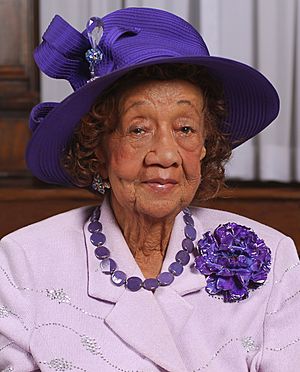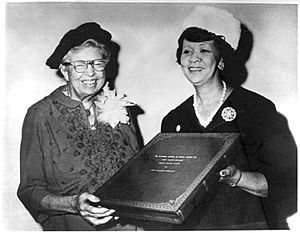Dorothy Height facts for kids
Quick facts for kids
Dorothy Height
|
|
|---|---|

Height in 2008
|
|
| Born |
Dorothy Irene Height
March 24, 1912 Richmond, Virginia, U.S.
|
| Died | April 20, 2010 (aged 98) Washington, D.C., U.S.
|
| Education | New York University (BA, MA) Columbia University |
Dorothy Irene Height (born March 24, 1912 – died April 20, 2010) was an important American leader. She worked hard for both civil rights and women's rights. Dorothy Height focused on helping African-American women. She tackled issues like finding jobs, learning to read, and understanding how to vote. Many people say she was the first leader in the civil rights movement to see that problems for women and African Americans were connected. She led the National Council of Negro Women for 40 years. Sadly, the news often overlooked her important role in the "Big Six" civil rights group because of sexism.
Contents
Early Life and Education
Dorothy Height was born in Richmond, Virginia, in 1912. When she was five, her family moved to Rankin, Pennsylvania. This was a steel town near Pittsburgh. She went to schools where students of all races learned together. Dorothy's mother was active in women's clubs. She often took Dorothy to meetings. This helped Dorothy feel like she belonged to a "sisterhood" of women.
Dorothy's journey with the YWCA started early. She joined a Girl Reserve Club in Rankin. She was very active and soon became president of her club. But she was shocked to learn she couldn't swim in the main YWCA pool because she was Black. Even though she argued, the rules didn't change back then. Later, Dorothy dedicated much of her work to changing the YWCA.
In high school, Dorothy became active in the anti-lynching movement. This movement worked to stop violent attacks against Black people. She was a great speaker. She won a national speaking contest and a $1,000 scholarship. Dorothy graduated from Rankin High School in 1929.
She was accepted to Barnard College in 1929. But the school had a secret rule. They only allowed two Black students each year. So, Dorothy was not allowed to attend. Instead, she went to New York University. She earned her first degree in 1932. The next year, she earned a master's degree in educational psychology. She also studied more at Columbia University.
Her Impact on Civil Rights

From 1934 to 1937, Dorothy worked for the New York City Department of Welfare. She said this job taught her how to handle disagreements. She learned to solve problems without making them worse. In 1937, she became a counselor at the Harlem YWCA. There, she met two very important women: Mary McLeod Bethune and Eleanor Roosevelt. They met at a meeting of the National Council of Negro Women (NCNW).
Dorothy wrote in her book about meeting Mary McLeod Bethune. She said Bethune inspired her to work for freedom. Bethune told her, "The freedom gates are half ajar. We must pry them fully open." Dorothy committed her life to this goal. The next year, Dorothy helped lead the YWCA's Emma Ransom House. She also worked with the United Christian Youth Movement. This group wanted to connect faith with real-world problems.
In 1939, Dorothy moved to Washington, D.C. She became an executive at the Phyllis Wheatley YWCA. In 1944, she returned to New York City. She joined the YWCA national staff. Her special job was to work on "Interracial Relations." This meant she trained people and wrote about race issues. Her understanding of both Black and white people's feelings was very important.
During this time, the YWCA created its Interracial Charter (1946). This charter promised to work for racial equality within the YWCA. It also pledged to fight against unfairness based on race. Dorothy believed that segregation caused prejudice. She led meetings and workshops. She also wrote articles to help white YWCA members. She wanted them to overcome their fears. She helped them live by the YWCA's principles of equality.
Dorothy was also very active in the Delta Sigma Theta sorority. She helped create leadership training programs. She was the national president of the sorority from 1947 to 1956. In 1950, she focused on training YWCA staff. In 1952, she was a visiting professor in India.
In 1963, the civil rights movement was gaining strength. The YWCA started a program to help integrate its branches. Dorothy took time off to lead this "Action Program." After two years, the YWCA decided to do even more. They wanted to fight all forms of racial segregation. They created an Office of racial integration. Dorothy was its first director. She helped the YWCA become fully integrated. She also helped recruit and keep African-American leaders. She retired from the YWCA in 1977.
In 1958, Dorothy became President of the National Council of Negro Women (NCNW). She held this position until 1990. She was part of the "Big Six" civil rights leaders. This group included Martin Luther King, Jr., and John Lewis. Civil rights leader James Farmer said the press often ignored Dorothy's role. This was because of sexism.
During the Civil Rights Movement, she organized "Wednesdays in Mississippi." This brought Black and white women together. They worked against segregation. Dorothy was a skilled speaker. She helped different groups talk to each other. She created understanding between people who were unfamiliar with each other.
Dorothy was a key organizer for the March on Washington for Jobs and Freedom in 1963. Even though she didn't speak, she helped make the event a success. She also represented the only women's organization at the march. Dorothy also started many international volunteer programs with the NCNW. These programs were in Asia, Africa, Europe, and South America.
In the mid-1960s, she wrote a column called "A Woman's Word." It appeared in the New York Amsterdam News, an African-American newspaper.
Dorothy worked hard to build a statue of Mary McLeod Bethune. This statue is in Lincoln Park, Washington, D.C. It was the first statue on federal land dedicated to a woman or an African-American person. At the statue's unveiling in 1974, Dorothy said it showed a growing appreciation. It honored the contributions of minorities and women in the U.S. She felt a Black woman best represented this.
Later Life and Legacy
In 1990, Dorothy and 15 other African-American women formed a group. They continued to advocate for women's rights and health. In 1994, President Bill Clinton gave her the Presidential Medal of Freedom. This is one of the highest honors for a civilian.
In 2002, Dorothy's 90th birthday party raised five million dollars. This money helped pay for the NCNW's headquarters in Washington, D.C. This building is now called the Dorothy I. Height Building. Famous people like Oprah Winfrey donated money.
Dorothy was also known for her amazing collection of hats. Many were made by a Black hat designer named Vanilla Beane. One of her hats was even featured on a U.S. postage stamp. Parts of her hat collection have been shown in museums.
A musical play called If This Hat Could Talk was based on her life. It showed her unique view of the civil rights movement. It also shared stories of the people who guided her, like Mary McLeod Bethune.
President Barack Obama called Dorothy Height "the godmother of the civil rights movement." He said she was a hero to many Americans. She attended the National Black Family Reunion every year until she passed away. She was also a leader in the Leadership Conference on Civil Rights. This group brings together many civil rights organizations. She was an honored guest at President Obama's inauguration in 2009.
Death
On March 25, 2010, Dorothy Height went to Howard University Hospital. She passed away less than a month later, on April 20, 2010. She was 98 years old. President Barack Obama spoke at her funeral. Many important people attended the service at the Washington National Cathedral. She was buried in Fort Lincoln Cemetery.
After her death, leaders suggested naming a post office after her. The former main post office in Washington, D.C., is now the Dorothy I. Height Post Office. This made her the only African-American woman to have a federal building in Washington, D.C., named after her.
Awards and Honors
Dorothy Height received many awards for her work:
- Presidential Citizens Medal (1989)
- Spingarn Medal from the NAACP (1993)
- Inducted into the National Women's Hall of Fame (1993)
- Presidential Medal of Freedom (1994)
- Congressional Gold Medal (2004)
- Honored on The Extra Mile Memorial in Washington, D.C. (2005)
- The Benning / Dorothy I. Height Neighborhood Library was named in her honor (2010).
- President Barack Obama ordered flags to be flown at half-mast for her funeral (2010).
- A callbox was dedicated to her on 7th Street, SW, in Washington, D.C. (2010).
- Google featured a special doodle for her 102nd birthday (2014).
- Honored with a U.S. Postage Stamp in the Black Heritage series (2016).
Dorothy Height once said, "I want to be remembered as someone who used herself and anything she could touch to work for justice and freedom. I want to be remembered as one who tried."
Images for kids
-
The Dorothy I. Height Building, headquarters of the National Council of Negro Women, located on Pennsylvania Avenue in Washington, D.C.
See also
 In Spanish: Dorothy Height para niños
In Spanish: Dorothy Height para niños



